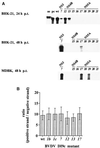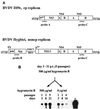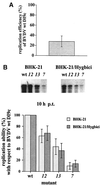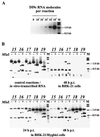Genetic analysis of the pestivirus nonstructural coding region: defects in the NS5A unit can be complemented in trans - PubMed (original) (raw)
Genetic analysis of the pestivirus nonstructural coding region: defects in the NS5A unit can be complemented in trans
C W Grassmann et al. J Virol. 2001 Sep.
Abstract
The functional analysis of molecular determinants which control the replication of pestiviruses was considerably facilitated by the finding that subgenomic forms of the positive-strand RNA genome of BVDV (bovine viral diarrhea virus) are capable of autonomous replication in transfected host cells. The prototype replicon, BVDV DI9c, consists of the genomic 5' and 3' untranslated regions and a truncated open reading frame (ORF) encoding mainly the nonstructural proteins NS3, NS4A, NS4B, NS5A, and NS5B. To gain insight into which of these proteins are essential for viral replication and whether they act in cis or in trans, we introduced a large spectrum of in-frame mutations into the DI9c ORF. Tests of the mutant RNAs in terms of their replication capacity and their ability to support translation and cleavage of the nonstructural polyprotein, and whether defects could be rescued in trans, yielded the following results. (i) RNA replication was found to be dependent on the expression of each of the DI9c-encoded mature proteins NS3 to NS5B (and the known associated enzymatic activities). In the same context, a finely balanced molar ratio of the diverse proteolytic processing products was indicated to be crucial for the formation of an active catalytic replication complex. (ii) Synthesis of negative-strand intermediate and progeny positive-strand RNA was observed to be strictly coupled with all functional DI9c ORF derivatives. NS3 to NS5B were hence suggested to play a pivotal role even during early steps of the viral replication pathway. (iii) Mutations in the NS3 and NS4B units which generated nonfunctional or less functional RNAs were determined to be cis dominant. Likewise, lethal alterations in the NS4A and NS5B regions were invariably noncomplementable. (iv) In surprising contrast, replication of functional and nonfunctional NS5A mutants could be clearly enhanced and restored, respectively. In summary, our data provide initial insights into the organization of the pestivirus replication machinery.
Figures
FIG. 1
Mutagenesis of the BVDV DI9c nonstructural polyprotein. Mutations were introduced into the cDNA of BVDV DI9c as described in the text. The schematic drawing represents the DI9c NS polyprotein NS3-NS5B, which corresponds to amino acids 1599 to 3907 of the BVDV CP7 polyprotein (19). The individual NS proteins resulting from proteolytic processing of the polyprotein are depicted as different shaded boxes. The positions of insertions, deletions, and substitutions are marked by symbols as indicated at the bottom. The variant RNAs are denoted by italic numbers. The mutagenized conserved amino acid motifs in the protease and ATPase/RNA helicase domains of NS3 and the NS5B RdRp, respectively, are marked by thin vertical lines and denoted according to the nomenclature of Gorbalenya and Koonin (11) and Lai et al. (17). For further details, see Table 2.
FIG. 2
Replication abilities and ratios of positive-strand RNA to negative-strand RNA of BVDV DI9c ORF mutants. (A) DI9c ORF derivatives (the same set of mutants analyzed in Fig. 3, 5, 6, and 7) were transfected into BHK-21 or MDBK cells. Identical numbers of cells were harvested at the indicated time p.t., and the cytoplasmic fractions were analyzed for newly synthesized positive-strand viral RNA by a quantitative RPA with 32P-labeled antisense probe A (see Materials and Methods and Fig. 4A). The protected fragments were separated on a 5% polyacrylamide gel containing 7 M urea and quantitated by phosphorimaging. (Top) RPA carried out with cytoplasmic RNA of transfected BHK-21 cells at 24 h p.t. Lanes: as, aliquot of input antisense probe; pc, RPA performed on 300 ng of in vitro-transcribed DI9c cRNA (positive control); wt, RPA with cytoplasmic RNA from wild-type DI9c transfected cells; italic numbers, identical experiments carried out with DI9c ORF mutants 7, 12, 13, 15, and 16 to 21 (numbering scheme as in Fig. 1 and Table 2). Mutant 15 was applied as a negative control. The protein-coding regions of DI9c which contain the various mutations are indicated. By quantitative evaluation of five independent transcription-transfection experiments, the relative replication abilities of mutants 12 and 13 were determined to correspond 63% ± 12% and 44% ± 14% of that of the wild-type replicon, respectively. (Middle and bottom) RPA of DI9c derivatives 7 and 15 to 21 at 48 h after transfection into BHK-21 and MDBK cells. Mutant 7 (replicating at 10% ± 4% of the efficiency of the wild-type DI9c) was used as a reference in these experiments because this RNA does not induce a CPE at this time point (for a quantitative analysis, see Fig. 5 and 6). Note that except for two RNAs (1b and 1c), which were analyzed in detail in reference , the transfection experiments with all DI9c ORF derivatives listed in Fig. 1 and Table 2 yielded negative results, i.e., blank gels at 24 h as well as at later time points p.t. (these data are summarized in Table 3). The latter mutants were also negative if tested by RT-PCR (data not shown). (B) Using sense and antisense probes during RPA, the ratio of progeny positive-strand RNA to negative-strand RNA intermediate was measured with all replication-competent DI9c ORF derivatives (1b, 1c, 7, 12, 13, and 17) and compared with the wild-type (wt) value. Error bars indicate the mean deviations of five independent transcription-transfection experiments.
FIG. 3
In vitro translation analysis of BVDV DI9c ORF mutants. In vitro translation reactions (see text) were programmed with in vitro-transcribed wild-type DI9c (wt) and a selection of mutant ORF RNAs (numbering refers to that in Fig. 1 and Table 2); the representative SDS-polyacrylamide gel shows the translation/processing data of those mutant RNAs which were further analyzed in Fig. 5 to 7. Also shown are data for RNAs which, besides the previously described NS3 mutants (see reference and Table 3), were anomalous with respect to polyprotein processing (see text). As in Fig. 2, the mutagenized regions of the applied DI9c derivatives are indicated. Molecular masses of marker proteins (M) are given on the left; positions of some of the mature BVDV-encoded proteins and uncleaved precursor proteins are marked on the right (for a better orientation, NS5AB is additionally marked with a square, NS34A is marked with a dot, NS4B5A is marked with an inverse triangle, and NS4AB is marked with a triangle). The proteins were identified as described in the text and/or by calculation of molecular weights. As a consequence of deletions or insertions, the migration behavior of some of the mature proteins was found to be modified (for example, mutants 16 and 17). For quantification of translation efficiencies, the amounts of Npro protein were measured with a phosphorimager. In five independent translation assays, the mean deviation in the level of translation was determined to be approximately 10% for each RNA. Significant variations in the rate of protein synthesis were not observed with each of the different RNAs, irrespective of whether translation was performed for shorter or longer intervals (data not shown). Note that translation or proteolysis was found to be unaffected for a number of mutants which were not analyzed on this gel. These data are summarized in Table 3.
FIG. 4
Establishment of a cell line containing a persistently replicating BVDV RNA (A) Side-by-side representation of the genome organization of the monocistronic, cytopathogenic (cp) BVDV DI9c replicon and of the bicistronic noncytopathogenic (noncp) BVDV Hygbici replicon. Boxes indicate the protein-coding regions; horizontal lines symbolize the UTR. The BVDV Hygbici replicon mainly corresponds to the bicistronic RNA Bi-NS2ins-, previously reported by Tautz et al. (29). The additional 5′-terminal ORF consists of a short sequence element of the Npro -coding region (FS) which was shown to be important for efficient BVDV IRES function (4, 6, 29) and which comprises the natural translational start codon. Moreover it contains a ubiquitin gene (ubi) and the hygromycin B phosphotransferase gene (hyg) with an artificial translational stop codon. The ubiquitin gene, which was fused in frame to the hyg ORF, enables generation of the authentic N terminus of the phosphotransferase by the activity of cellular ubiquitin C-terminal hydrolases. The second ORF located downstream of the EMCV (encephalomyocarditis virus) IRES encodes the pestiviral NS proteins; p7∗ denotes the 3′-terminal part of the p7-coding unit which comprises the cleavage site for generation of the correct N terminus of NS2. The (antisense) RNA probes used in the differentiating RPAs (see text) are schematically drawn at their positions of hybridization (see text). Probe A was used to specifically detect BVDV DI9c-derived RNAs; probe B was employed for the specific detection of BVDV Hygbici RNA; probe C served to monitor replication of any BVDV CP7-derived RNA. (B) Monitoring replication of BVDV Hygbici RNA in BHK-21 cells. In vitro-synthesized BVDV Hygbici cRNA (5 μg) was transfected into BHK-21 cells. Hygromycin B (500 μg/ml) was added to the culture medium 3 days p.t. From day 3 to 31 p.t., the cells were continuously grown and passaged five times in this medium. At day 31 p.t., the cell population was divided into two aliquots; one portion was cultured in normal medium, and the other was grown under constant selection pressure in antibiotic-containing medium. At the given time points and number of passages after separation, an aliquot of each isolated cell population was analyzed for the presence of the noncytopathogenic replicon using RPA with antisense probe C. Lane c, RNase protection with 300 ng of in vitro-synthesized BVDV Hygbici cRNA (positive control).
FIG. 5
Complementation experiments with BHK-21/Hygbici cells to enhance the replication of the functional DI9c NS3 and NS4B mutants. (A) General replication competence of wild-type (wt) DI9c in BHK-21/Hygbici cells. Identical amounts of DI9c cRNA were transfected into BHK-21 cells and BHK-21/Hygbici cells. Equal numbers of cells were harvested at 10 h p.t., and identical amounts of the cytoplasmic fractions were analyzed by RPA using the DI9c-specific probe A (Fig. 4A and panel B). The major protected bands were quantified by analysis with a phosphorimager. The replication efficiency of DI9c RNA in Hygbici cells was calculated with respect to its replication competence in normal BHK cells (set as 100%). The average value of three independent transfection experiments is depicted as a column diagram; the mean deviation is indicated by the error bar. The same experiments performed at different time points (prior to the onset of a DI9c-induced CPE) and with MDBK cells yielded congruent results (data not shown). (B) Comparison of replication abilities of the functional mutants 7, 12, and 13 in BHK-21/Hygbici and normal cells. The wild-type DI9c replicon (wt) and the DI9c ORF mutants 7, 12, and 13 were transfected into Hygbici and normal cells. Equal numbers of cells were harvested at 10 h p.t., and identical amounts of the cytoplasmic fractions were analyzed by DI9c-specific RPA (see above). A representative RPA is shown at the top (mock controls yielded a blank gel and are not shown). The same experiments analyzed at different time points yielded congruent results. As indicated in panel A, replication of the DI9c derivatives was found to be generally lower in Hygbici cells. The signals obtained for the different replicons were quantified, and their relative replication abilities in each cell line were calculated with respect to the wild-type replicon (estimated as 100% replication competent). The average values of three independent transfection experiments are presented in the column diagram below. Mean deviations are indicated by error bars. Experiments with other functional DI9c NS3 derivatives (1b and 1c) yielded analogous results; i.e., a significant enhancement of the replication ability could not be observed in BHK-21/Hygbici cells (data not shown).
FIG. 6
Complementation experiments with BHK-21/Hygbici and MDBK/Hygbici cells. (A) Replication abilities of a selected set of DI9c ORF derivatives (the same mutants as analyzed in Fig. 2) in BHK-21/Hygbici and MDBK/Hygbici cells. As in the previous experiments, mutant 7 was used as an internal, positive control (see text) and mutant 15 was applied as a negative control. The representative RPA experiments were performed at 24 h and/or 48 h after transfection of the indicated cell type. Identical numbers of cells were harvested, and aliquots of cytoplasmic RNA preparations were monitored with the DI9c-specific riboprobe (Fig. 4A) for de novo-synthesized positive-strand RNA. Lanes: pc, RPA with 200 ng of in vitro-synthesized DI9c cRNA (positive control); nc, RPA of the cytoplasmic fraction of mock-transfected Hygbici cells (negative control); italic numbers, identical experiments carried out with cells which had been transfected with the diverse ORF mutants (numbering scheme as described above). (B) Comparison of the replication abilities of mutant RNAs 7 and 16 to 19 in Hygbici and normal cells. RNAs 16 to 19, 7, and 15 (negative control) were transfected into naive BHK-21 and MDBK cells (Fig. 2) or BHK-21/Hygbici and MDBK/Hygbici cells (A). Identical amounts of cells and cytoplasmic extracts were analyzed by RPA at the indicated time points p.t.; the major protected bands were quantified by phosphorimager analysis. The relative replication abilities of mutants 16 to 19 were determined with respect to mutant 7, which served as a reference replicon (and set to 100 relative units of replication ability). The average values of three independent transcription-transfection experiments are depicted as a column diagram; error bars indicate mean deviations. Note that mutant 7 induced a slight CPE in both types of Hygbici cells at 48 h p.t. (as indicated by the arrow). Therefore, the replication capacities of mutants 16 to 19 could be quantified definitively at 24 h p.t. However, the 48-h values clearly show restoration and enhancement of the replication abilities of mutants 16 to 19 in BHK-21/Hygbici and MDBK/Hygbici cells, repectively.
FIG. 6
Complementation experiments with BHK-21/Hygbici and MDBK/Hygbici cells. (A) Replication abilities of a selected set of DI9c ORF derivatives (the same mutants as analyzed in Fig. 2) in BHK-21/Hygbici and MDBK/Hygbici cells. As in the previous experiments, mutant 7 was used as an internal, positive control (see text) and mutant 15 was applied as a negative control. The representative RPA experiments were performed at 24 h and/or 48 h after transfection of the indicated cell type. Identical numbers of cells were harvested, and aliquots of cytoplasmic RNA preparations were monitored with the DI9c-specific riboprobe (Fig. 4A) for de novo-synthesized positive-strand RNA. Lanes: pc, RPA with 200 ng of in vitro-synthesized DI9c cRNA (positive control); nc, RPA of the cytoplasmic fraction of mock-transfected Hygbici cells (negative control); italic numbers, identical experiments carried out with cells which had been transfected with the diverse ORF mutants (numbering scheme as described above). (B) Comparison of the replication abilities of mutant RNAs 7 and 16 to 19 in Hygbici and normal cells. RNAs 16 to 19, 7, and 15 (negative control) were transfected into naive BHK-21 and MDBK cells (Fig. 2) or BHK-21/Hygbici and MDBK/Hygbici cells (A). Identical amounts of cells and cytoplasmic extracts were analyzed by RPA at the indicated time points p.t.; the major protected bands were quantified by phosphorimager analysis. The relative replication abilities of mutants 16 to 19 were determined with respect to mutant 7, which served as a reference replicon (and set to 100 relative units of replication ability). The average values of three independent transcription-transfection experiments are depicted as a column diagram; error bars indicate mean deviations. Note that mutant 7 induced a slight CPE in both types of Hygbici cells at 48 h p.t. (as indicated by the arrow). Therefore, the replication capacities of mutants 16 to 19 could be quantified definitively at 24 h p.t. However, the 48-h values clearly show restoration and enhancement of the replication abilities of mutants 16 to 19 in BHK-21/Hygbici and MDBK/Hygbici cells, repectively.
FIG. 7
Restoration or enhancement of the replication ability of DI9c NS5A mutants 16 to 19 cannot be explained by RNA recombination. (A) Detection level of quantitative RT-PCR. Applying primers B53 R and B42 (see Materials and Methods), RT-PCR was carried out with different amounts of in vitro-transcribed DI9c RNA. The standard reaction was carried out in parallel with the reactions shown in panel B. The detection limit was thus demonstrated to be 5 fg (corresponding 103 molecules) of DI9c RNA. (B) RT-PCR analysis of the DI9c ORF mutant RNAs after transfection into naive BHK or BHK/Hygbici cells. Mutants 15 to 19 (15 as a negative control) were transfected into normal BHK and BHK/Hygbici cells. The naive cells were harvested at 48 h p.t. (top right); the Hygbici cells were divided into two portions and harvested at 24 and 48 h p.t., respectively (bottom). RT-PCR was carried out on identical amounts of cytoplasmic RNA. Primers B49R (mutants 15 to 17) and B53R (mutants 18 and 19) were used for reverse transcription; primers B49R and B38 (mutants 15–17) and primers B53R and B42 (mutants 18 and 19) were used for the subsequent PCRs (Table 1). As a positive control, the RT-PCRs were performed on the in vitro-transcribed mutant RNAs (top left). The resulting DNA fragments, which were confirmed to comprise the expected portion of the NS5A-coding region by sequencing (data not shown), had sizes of 1.2 kb (mutants 15 to 17) and 1.1 kb (mutants 18 and 19). In addition, RT-PCR with primers B49R and B38 gave rise to an unspecific product of ca. 0.4 kb (see also control reactions). Replication of the mutant DI9c RNAs was confirmed via restriction digest of the RT-PCR products with _Mlu_I, because this restriction site was originally introduced into the mutant cDNA constructs (see Materials and Methods and control reactions). Digestion with _Mlu_I should yield the following fragments: mutant 15, 1.10 and 0.10 kb; mutant 16, 0.77 and 0.43 kb; mutant 17, 0.96 and 0.24 kb; mutant 18, 0.81 and 0.29 kb; mutant 19, 0.67 and 0.43 kb. Lanes: M, DNA length marker; italic numbers, assays performed on either in vitro-transcribed RNAs (top left) or cytoplasmic RNA fractions of BHK cells (top right) or Hygbici cells (bottom) which had been transfected with DI9c derivatives 15 to 19. Plus signs indicate that the PCR products were digested with _Mlu_I. Positions of the 0.5- and 1.0-kb marker fragments are given on the right. The _Mlu_I cleavage products are marked by dots.
Similar articles
- Assignment of the multifunctional NS3 protein of bovine viral diarrhea virus during RNA replication: an in vivo and in vitro study.
Grassmann CW, Isken O, Behrens SE. Grassmann CW, et al. J Virol. 1999 Nov;73(11):9196-205. doi: 10.1128/JVI.73.11.9196-9205.1999. J Virol. 1999. PMID: 10516027 Free PMC article. - Characterization of an autonomous subgenomic pestivirus RNA replicon.
Behrens SE, Grassmann CW, Thiel HJ, Meyers G, Tautz N. Behrens SE, et al. J Virol. 1998 Mar;72(3):2364-72. doi: 10.1128/JVI.72.3.2364-2372.1998. J Virol. 1998. PMID: 9499097 Free PMC article. - Generation and characterization of a hepatitis C virus NS3 protease-dependent bovine viral diarrhea virus.
Lai VC, Zhong W, Skelton A, Ingravallo P, Vassilev V, Donis RO, Hong Z, Lau JY. Lai VC, et al. J Virol. 2000 Jul;74(14):6339-47. doi: 10.1128/jvi.74.14.6339-6347.2000. J Virol. 2000. PMID: 10864644 Free PMC article. - Non-structural proteins of bovine viral diarrhea virus.
Chi S, Chen S, Jia W, He Y, Ren L, Wang X. Chi S, et al. Virus Genes. 2022 Dec;58(6):491-500. doi: 10.1007/s11262-022-01914-8. Epub 2022 May 25. Virus Genes. 2022. PMID: 35614328 Free PMC article. Review. - Molecular virology of hepatitis C virus: an update with respect to potential antiviral targets.
Blight KJ, Kolykhalov AA, Reed KE, Agapov EV, Rice CM. Blight KJ, et al. Antivir Ther. 1998;3(Suppl 3):71-81. Antivir Ther. 1998. PMID: 10726057 Review.
Cited by
- Classical swine fever virus NS5A protein antagonizes innate immune response by inhibiting the NF-κB signaling.
Sun J, Li J, Li L, Yu H, Ma P, Wang Y, Zhu J, Feng Z, Tu C. Sun J, et al. Virol Sin. 2023 Dec;38(6):900-910. doi: 10.1016/j.virs.2023.09.002. Epub 2023 Sep 14. Virol Sin. 2023. PMID: 37714433 Free PMC article. - Atypical Porcine Pestiviruses: Relationships and Conserved Structural Features.
Riedel C, Aitkenhead H, El Omari K, Rümenapf T. Riedel C, et al. Viruses. 2021 Apr 26;13(5):760. doi: 10.3390/v13050760. Viruses. 2021. PMID: 33926056 Free PMC article. Review. - Membrane Topology of Pestiviral Non-Structural Protein 2 and determination of the minimal autoprotease domain.
Walther T, Fellenberg J, Klemens O, Isken O, Tautz N. Walther T, et al. J Virol. 2021 May 10;95(11):e00154-21. doi: 10.1128/JVI.00154-21. Epub 2021 Mar 17. J Virol. 2021. PMID: 33731461 Free PMC article. - CRISPR/Cas9-Mediated Knockout of DNAJC14 Verifies This Chaperone as a Pivotal Host Factor for RNA Replication of Pestiviruses.
Isken O, Postel A, Bruhn B, Lattwein E, Becher P, Tautz N. Isken O, et al. J Virol. 2019 Feb 19;93(5):e01714-18. doi: 10.1128/JVI.01714-18. Print 2019 Mar 1. J Virol. 2019. PMID: 30518653 Free PMC article.
References
- Agol V I, Paul A V, Wimmer E. Paradoxes of the replication of picornaviral genomes. Virus Res. 1999;62:129–147. - PubMed
- Andino R, Rieckhof G E, Baltimore D. A functional ribonucleoprotein complex forms around the 5′ end of poliovirus RNA. Cell. 1990;63:269–380. - PubMed
- Blight K J, Kolykhalov A A, Rice C M. Efficient initiation of HCV RNA replication in cell culture. Science. 2001;290:1972–1974. - PubMed
Publication types
MeSH terms
Substances
LinkOut - more resources
Full Text Sources
Other Literature Sources






